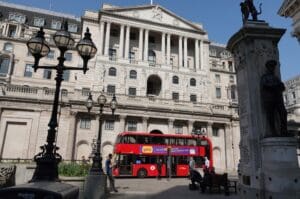
As more Bank of England (BoE) interest rate cuts are expected to take place over the second half of 2025, it’s time to assess whether it’s time to take a fresh look at your investment strategy.
Following a period where the BoE began hiking rates in late 2021 as a result of rising inflation, a series of cuts began in August last year.
Since then, four rate cuts have brought the UK base rate down from 5.25% to 4.25%, with the most recent cut arriving in May.
So, what’s next? With inflation still hovering around 3.6%, still well above the BoE’s target of 2%, it’s unlikely that we’ll see any significant cuts to the base rate beyond .25 basis points spread over the months ahead.
Despite this, ING is anticipating two more interest rate cuts in 2025, arriving in August and November to bring the base rate down to 3.75. However, weakening UK economic data could see the cuts gather momentum, bringing the base rate lower.
Deutsche Bank believes that additional cuts could be on the way this year, bringing the base rate to 3.5% by the end of 2025, while Pantheon Macroeconomics has taken a more prudent approach in forecasting just one more cut this year, arriving in November.
Looking further afield, Oxford Economics is predicting that the Bank of England’s base rate will eventually fall to 2.5% in 2027, where it will largely remain throughout 2028 and 2029.
What does this mean for UK investors? Let’s take a deeper look at how falling interest rates can impact the investment outlook and how to make the most of base rate cuts:
Investing to Trump Savings
Adults in the United Kingdom are predominantly savers, as opposed to investors, preferring to place their wealth into fixed-rate investments rather than floating their money on more speculative investments like stocks and shares, for instance.
While ISAs are an increasingly popular way for savers and investors alike to build their income in a tax-efficient way, just 7.8 million individual savings account holders have opened a Stocks and Shares ISA, while 18 million hold Cash ISA accounts.
While Stocks and Shares ISAs focus on investing money, Cash ISAs are more focused on savings.
Because Cash ISA returns are heavily linked to the Bank of England’s base rate of interest, lower rates can mean weaker returns. Likewise, lower interest rates and a less costly borrowing environment for businesses generally point to stronger stock market growth, making Stocks and Shares ISAs more attractive for investors seeking to build their wealth.
Crucially, if Cash ISA returns fall below inflation rates, savers will be making a loss in real terms, so it’s imperative to keep BoE base rate changes in mind.
This trend has been prevalent for some time, thanks to exceptionally strong financial markets in recent years. As a result, the average rate of return for a Stocks and Shares ISA over the past decade is 9.6%, while Cash ISAs average out at 1.2% over the same period.
Adopting a Long-Term Mindset
Long-term investing options, like Stocks and Shares ISAs, can not only open the door to more attractive potential returns than Cash ISA interest rates, but are also recommended for individuals to maximise their ISA returns without losing sight of their investment objectives.
This approach is already being undertaken by many investors who are unsure about the market volatility that’s been steadily emerging from US President Trump’s bold tariff strategies and their impact on world trade.
Taking a more long-term mindset could help you to avoid losing out due to short-term fluctuations and base rate cuts while staying committed to your wider goals.
Impact on Bonds
Because bonds essentially behave as an IOU, the BoE base rate can impact the amount of interest investors can expect to receive in the future by taking them out.
Despite this, many investors like to add bonds to their portfolio because their prices generally move in the opposite direction to stocks and shares, helping the strategy to serve as a hedge against more speculative investments. This can be especially true for developed market government bonds.
Even in a low interest rate environment, it’s possible to access high-yield bond funds; however, these will be largely comprised of companies that have a weaker credit rating. With this in mind, it’s important to check your risk tolerance before proceeding with riskier bonds.
Preparing for Rate Changes
Whether you’re more comfortable as a saver or investor, the Bank of England base rate changes can come with significant implications for your wealth-building strategies.
With this in mind, it’s worth assessing your long-term strategy and comparing its effectiveness in the face of future interest rate forecasts. If you run the risk of losing out on your anticipated returns, you may need to rethink your approach.
There’s no right or wrong way to manage a low interest rate environment, and your decisions should reflect your own personal risk appetite. The best preparation for a base rate cut is to factor in changes well in advance; that way, you can create a sustainable investment strategy that continues to deliver the returns you’re expecting long into the future.
Read more:
How Low Will UK Interest Rates Go and What Does it Mean for Investors?






